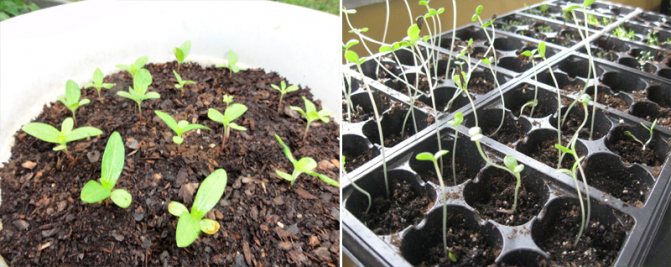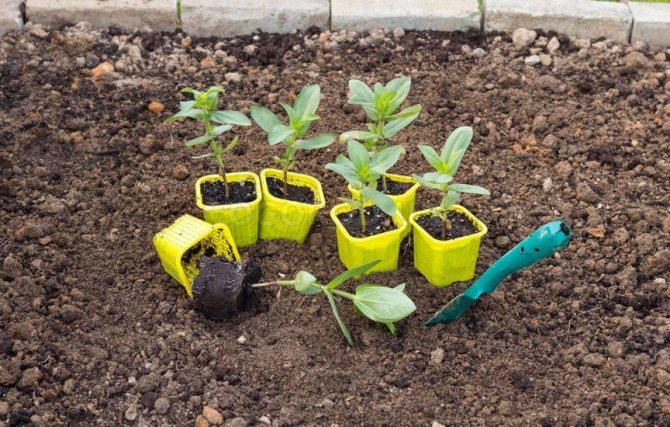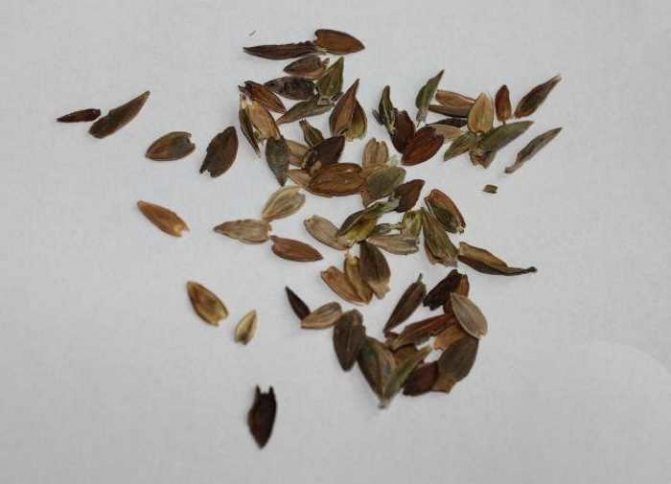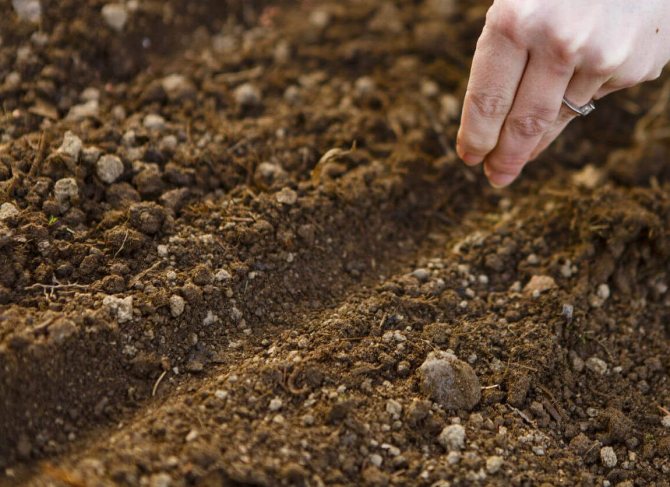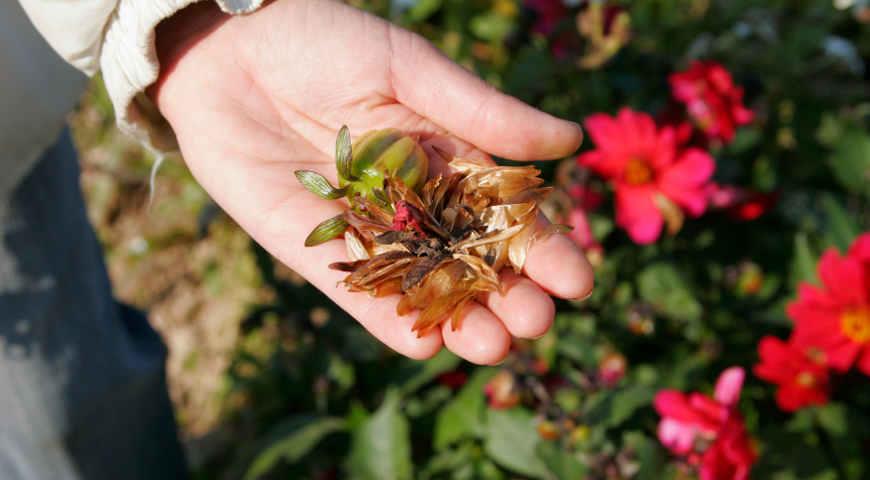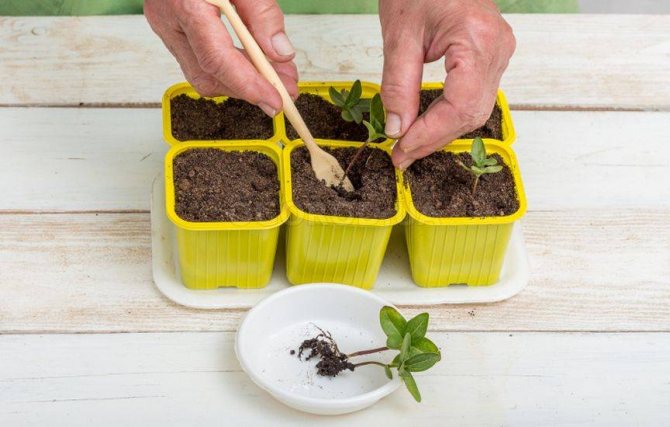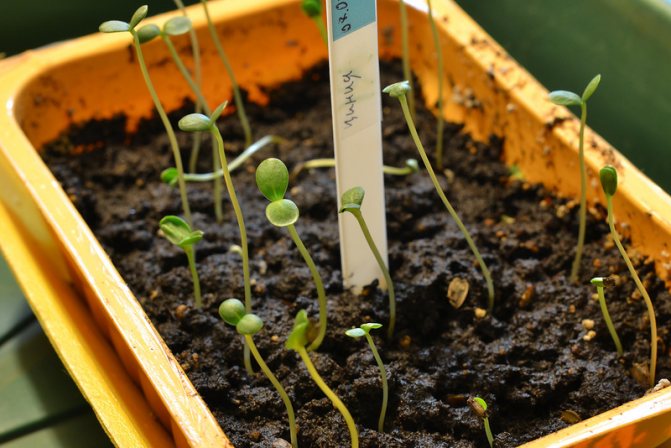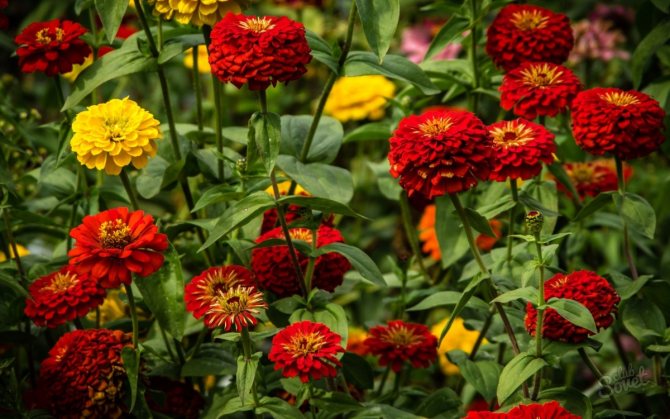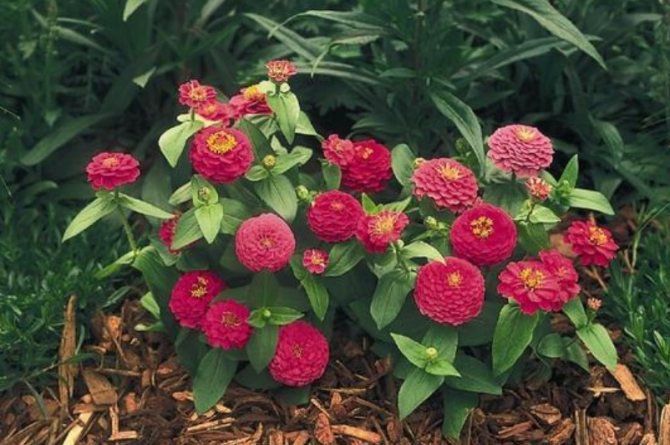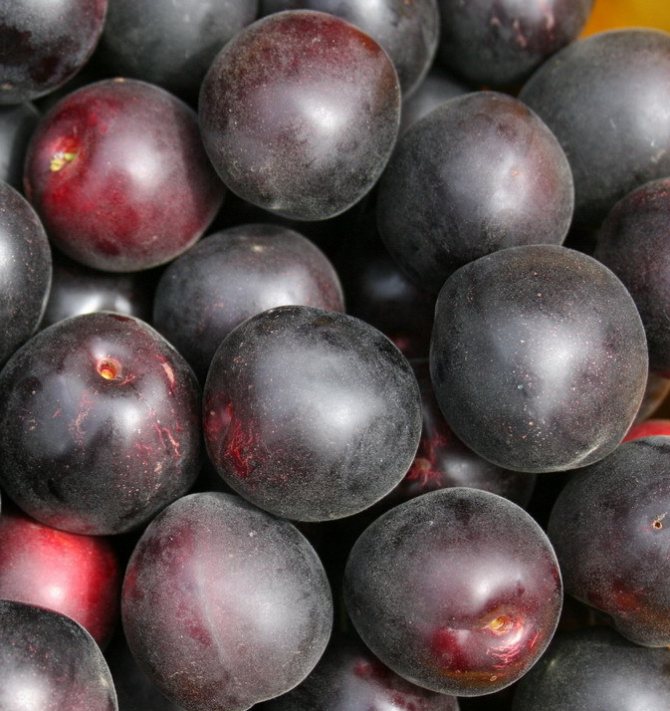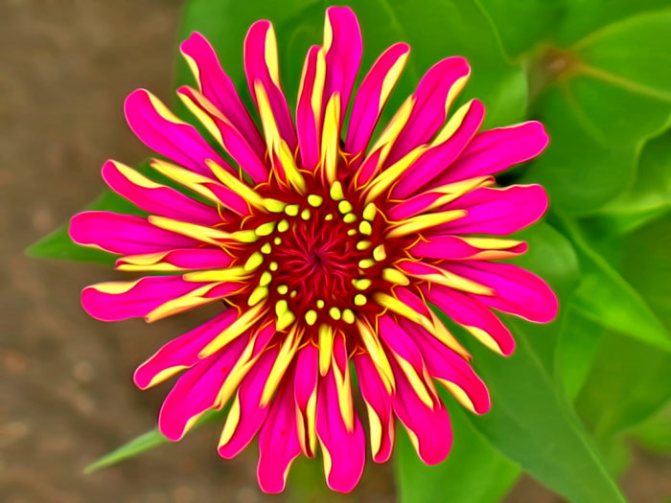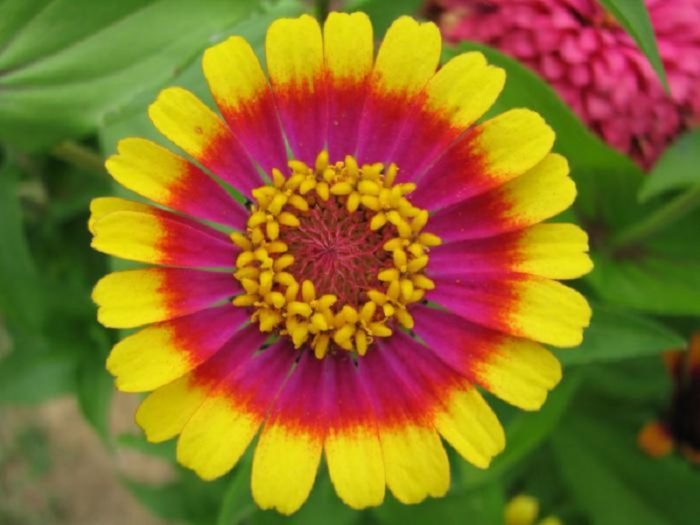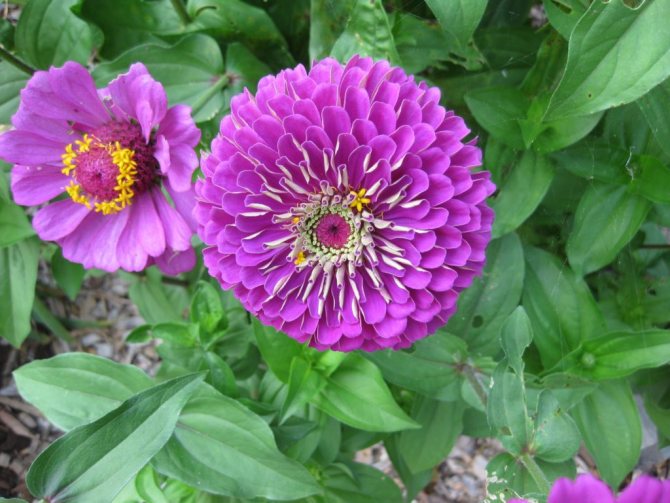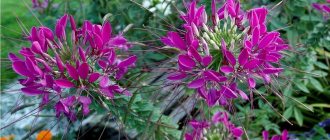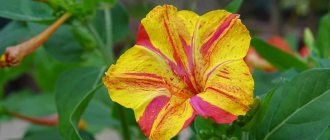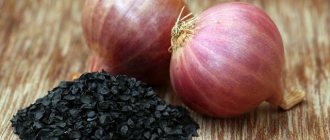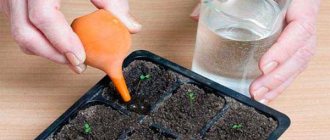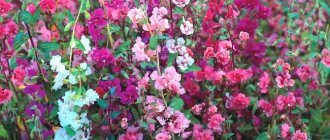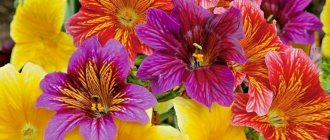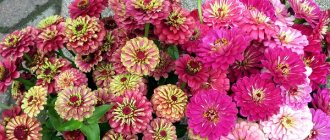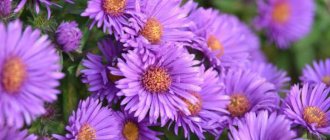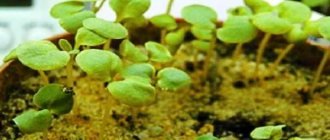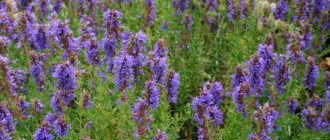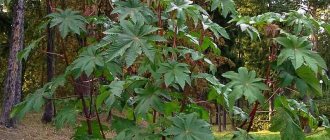Zinnia is a beautiful flower loved by many flower growers for its unpretentiousness, long and abundant flowering. Cut zinnia retains its charm and decorates bouquet arrangements for 14 days. it annual plant possesses a wealth of bright colors and helps to form landscaping and beautiful flower beds.
The increased sensitivity of zinnia to subzero temperatures allows you to admire the beauty of this flower only in the warmer months. With the onset of cold weather, the flower dies. Perennial varieties grow only in warm countries.
Sowing dates
For zinnia, the optimal time for sowing seeds for seedlings has long been determined: it falls in mid-April. Not every gardener has the opportunity to plant exactly on these dates, so you need to understand why they are recommended and what their non-compliance is fraught with, as well as how to help flowers planted at a different time.
Early dates
If you sow zinnia much earlier - in March or February, then after the appearance of the first seedlings, they may not have enough natural light. In the case when the florist is determined to get flowering bushes before the standard time, he will have to provide additional lighting using phytolamps with violet light in the 440-445 nm spectrum. It is this wavelength that is necessary for the successful development of the vegetative parts of the plant, which are formed within two months after sowing.
It is possible to illuminate the seedlings only in the morning and evening hours, when it is already dark outside the window, but most often the supplementary lighting is carried out throughout the day. It is important to remember that phytolamps are not a complete substitute for sunlight, but they can reduce stress from a lack of illumination.
A more affordable option is to use fluorescent lamps. Zinnias will suffer more with this, but still a little support with a short daylight will be provided.
If planted too early, the bush may stretch out, its internodes will be longer than the required size, and the stem will be thin and fragile. This complicates transportation to the planting site in open ground and makes the plant brittle.
How and when to collect seeds
A couple of months after the buds appear, you can start collecting seeds for the next season. The largest heads are suitable for this. These are, as a rule, the first inflorescences. Seeds in dry brown buds are considered ripe. There is no particular difficulty in collecting seed material, they are quite large.

The seeds of the culture are very large, so there should not be any difficulties in collecting them.
How to collect seeds
Mature flower heads are carefully cut and laid out to dry in a windless warm room. Seed material is collected from dry inflorescences by shaking out.
For your information! Seeds remain viable for up to 4 years. They should be stored in paper bags in a dry place.
Remarkably, in one inflorescence there are seeds of different types. Plants of different colors grow from them. Thyroid seeds will give flowers with a single-row arrangement of petals, and triangular and lanceolate - semi-double buds. If an oblong seed with an awl-like tail, then this is the third type. Time will tell what will come of it. Thus, a scattering of various types and colors of zinnia can be grown from one head.
Note! Seeds from the first few buds have the highest probability of repetition of parental qualities and are distinguished by excellent germination.
Seed selection and planting time
Zinnias are sown on seedlings no earlier than April. Given the monthly growing period of seedlings, for a cold climate, sowing is more appropriate in May. If there is a choice, seeds should be selected for freshness, since germination decreases every year.
Preparing seeds for planting seedlings
Before sowing, the material must be prepared. To identify germinating seeds, it is enough to soak them in a cloth soaked in epin. After a couple of hours, you can choose shiny and dense specimens for sowing.
For your information! Freshly harvested seeds will hatch in a couple of days, and old ones will sprout in a week.
Sowing seeds in the spring directly into the ground
This crop does not tolerate transplanting, so it is best to sow seeds directly into the ground. To avoid freezing of sprouts, the seedling bed can be covered with plastic wrap. Even in southern regions in open ground, it is recommended to sow at the end of May - at the beginning of June. True, the flowering of the plant will be delayed for a couple of weeks, but the plantings themselves will be stronger and healthier.
Moon calendar
Novice gardeners often neglect the recommendations of the lunar calendar for sowing dates, but those who have been growing flowers for a long time know that this factor is best taken into account. To choose the most suitable sowing time, you should carefully read the Lunar calendar for April 2020. In it, you should familiarize yourself with the phases of the moon.
Sowing on the right day increases the germination rate of zinnia, promotes the formation of a strong and branched root system, initiates the growth of all aboveground organs and ultimately makes the seedlings healthier and more viable.
In April 2020, the most favorable days for sowing ornamental plants for seedlings will be as follows:
- April 1, Wednesday. The first quarter of the lunar cycle, 8, 9 lunar day.
- April 2, Thursday. The growing moon, 9, 10 lunar day.
- April 28, Tuesday. The growing moon, 6, 7 lunar day.
Since zinnia should be planted in mid-April, the following dates should be chosen:
- April 14, Tuesday;
- April 18, Saturday;
- April 19, Sunday.
Sowing on these dates will ensure the normal development of seedlings and the formation of a large number of buds on adult plants.
It is not worth sowing zinnia seeds on April 15, 16 and 17, since these days are unfavorable according to the lunar calendar.
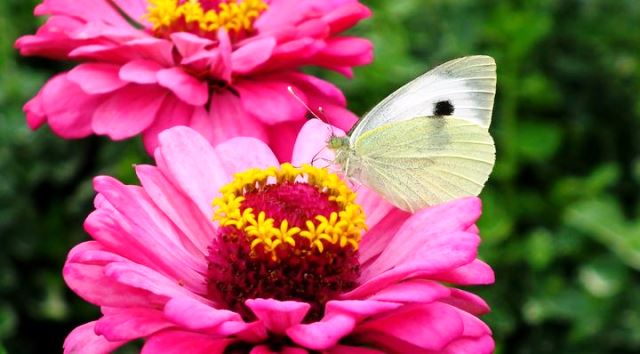

How to care for majors
Photos of zinnia flowers are beautiful: these large inflorescences of all kinds of shapes and colors will be a real decoration for any garden. What will especially delight the florist who opted for the majors is that they do not need complicated care at all.
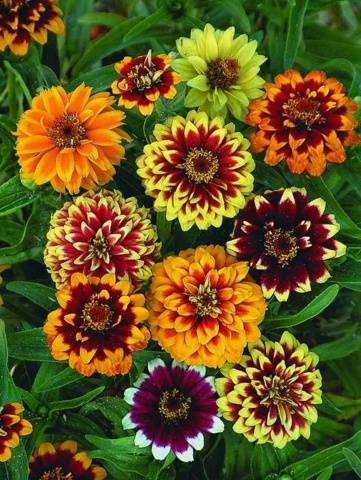

The whole care of zinnia consists of such simple actions:
- you need to fertilize the flowers only twice a season (one month after planting the seedlings and immediately before flowering). Both a mineral complex and a liquid mullein solution are suitable as fertilizers. You need to apply fertilizers in liquid form, watering the flowers at the root.
- If the grower needs low, but dense bushes of zinnia, then the flowers can be pinched. This is done even in the seedling stage, when several pairs of true leaves appear on the plants. Pinching is done over 4-5 sheets. It is possible to form a bush of majors in a flower bed, but they do it before the budding period.
- During periods of severe drought, zinnia needs to be watered, water is applied strictly at the root, trying not to wet the leaves and flowers. Of the pests for majors, the most dangerous are aphids, May beetles, slugs and snails. The latter two need to be dealt with “manually”: collect gastropod pests, spread slate near flowers, or mulch the soil with large sawdust. With insects, everything is easier - the flowers are sprayed with chemical insecticides a couple of times.
- Zinnia can also get sick, usually fungal infections or all kinds of rot. It is extremely difficult to deal with such diseases; you have to remove the affected flowers completely. Therefore, it is better to prevent infection and adhere to the recommendations for growing majors: plant flowers in a sunny place, do not thicken the planting, do not be zealous with watering.
At the end of the season, zinnias are simply pulled out along with the roots and destroyed in order to plant seedlings of new flowers on the flower bed next spring.
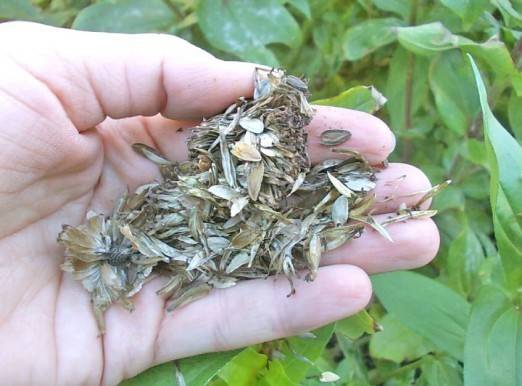

Attention! Zinnia seeds are harvested, somewhere, two months after the start of flowering. They choose the largest inflorescences and wait until they turn brown. The flowers are cut and dried, then the seeds are shaken out.
Choosing a container for planting
Zinnia seeds should be planted in separate containers.
The main thing is that in each container in which you will grow seedlings there are drainage holes, they are needed so that moisture does not collect and the roots do not rot. If there were no holes in the container initially, make them yourself, you can use:
- nails;
- scissors;
- awl.
If you decide to sow zinnia seeds for seedlings in a common box, then you should choose a wide container for this, so that you can leave the necessary gap between the seeds. Thanks to this, you can do without picking, the suitable height of the box is 10 centimeters.
Landing in the ground
With how to grow zinnia seedlings, everything is clear, it remains to figure out how to plant these flowers in a permanent place. The best time for planting seedlings in the ground will be the end of May, in the northern regions it is better not to rush and wait for the June heat (after all, the cold is destructive for zinnias).
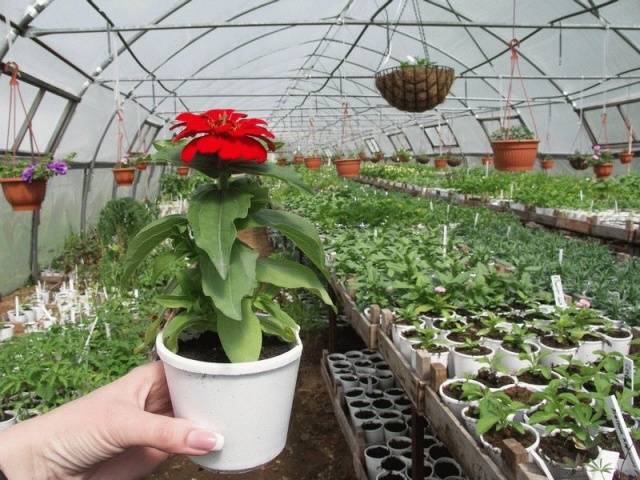

When the soil warms up well, you can start preparing:
- Containers with seedlings are thoroughly spilled with warm water so that the branched roots of zinnia are easily separated from each other.
- Choose an area well-lit by the sun on a flower bed, closed from drafts and wind. The soil there should be neutral, nutritious, well-drained. Therefore, if the soil does not meet these requirements, it must be prepared (deacidify, add sand and peat, feed with mineral fertilizers).
- Given the spreading nature of the zinnias, holes are made at a distance of at least 35 cm from each other. The depth of the holes should be about 10-15 cm.
- Seedlings are transferred to a permanent place by transshipment or flowers are planted in peat cups (tablets). You need to act very carefully, since the majors do not tolerate transplantation well, their roots are easily injured.
- Squeeze the soil around the stem of the seedling and water each plant with warm water.
Advice! In order to prevent the germination of weeds and premature drying of the soil, you can mulch the soil in the flower bed with sawdust or peat.
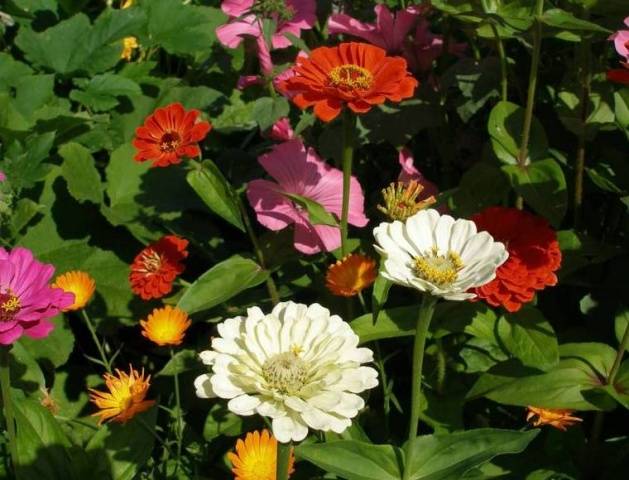

Growing directly from seeds is also quite suitable for zinnias, because these flowers do not like transplanting. If the weather is still cool in the region, and it's time to sow flowers, you can create a mini-greenhouse over the crops by simply pulling on a plastic wrap. In the southern regions, zinnia seeds are simply sown in the ground in late May or early June. In this case, the flowering of majors will be later (by 2-3 weeks), but the plants will be much healthier and stronger.
Basic rules for caring for zinnia seedlings
To be able to wait for the successful growth of seeds at home, you need to constantly look after the seedlings.
We propose to study the following factors for caring for seedlings:
- temperature regime - watch the temperature, it can only be in the range of 23 - 25 degrees Celsius, and after the seeds germinate 18 - 20 degrees during the day and 18 - 16 at night;
- lighting - just like any type of seedling, zinnia needs sunlight, if it is not enough, then it is worth using additional lighting;
- watering the seedlings - it is necessary to strictly monitor the moisture and maintain its control in the soil, drying out and an excess of water are also dangerous, all this will negatively affect the sprout;
- pinching - if you want the flowering to become more magnificent, you cannot do without it, it is done on the fourth and fifth leaves;
- adding soil - it is necessary when the plant grows up and forms several true leaves;
- hardening of seedlings - it is necessary for the plant to adapt as quickly as possible before it is planted in the ground, it is best to harden only two weeks before transplanting. To do this, you need to keep the window open, and when the air temperature outside reaches 15 degrees, you can gradually expose it to the balcony.
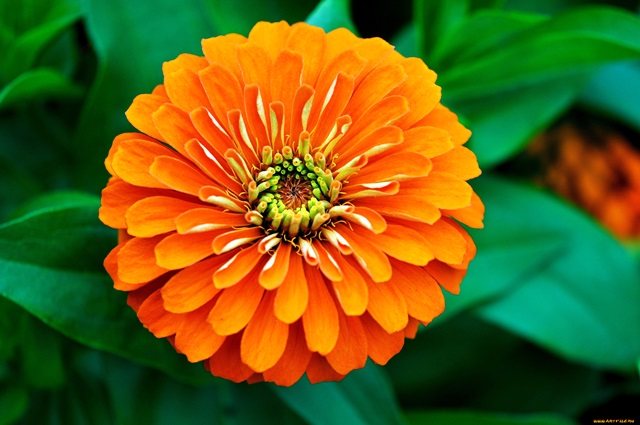

Varieties and types
Flower growers have been growing zinnia at home for over 200 years. Breeders have bred many different varieties, each of which is very beautiful. The varieties have a wide range of colors. Flowers differ in bush size and flower shape. The plant has more than 20 species. But only some of them are grown at home. In addition to the main species, there are still a large number of subspecies.
Perennial


In our latitudes, this species is exclusively annual, since it does not tolerate frost. At the same time, in their homeland, in Mexico and America, many seasons are grown. In our country, such cultivation is possible only in a closed room. Perennial varieties include:
- narrow-leaved zinnia;
- California giant zinnia;
- scabiozoan zinnia;
- giant cactus zinnia;
- graceful qinyai.
Perennial zinnias grow up to a meter in height. The color range of the buds can be of three colors. They are orange, white, or pink. The leaves grow up to 7 cm, and the diameter of the flowers reaches 15 cm, while the size of each petal is up to 4 cm.
Gerginaceous
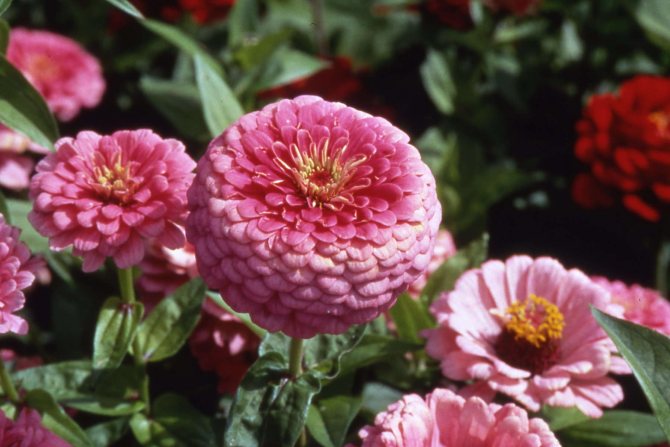

This species has a kind of doubleness of flowers. Their diameter reaches 15 cm. In height, the plant can reach more than a meter. The flowers of the plant can be of various colors: lilac, white, purple, yellow, pink.
This species has several varieties:
- Violet - blooms with bright purple buds
- polar bear - blooms with white buds
- Dream - blooms with pink buds. This look looks great in bouquets.
Bush undersized
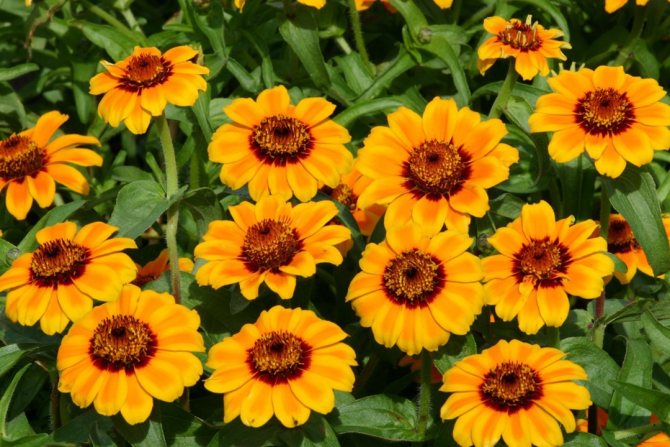

The height of the stems of this type of undersized zinnia does not exceed half a meter. The stems are very branched, with a lot of buds. The species has a wide range of colors, it is intended exclusively for planting in flower beds.
Pompom or midget
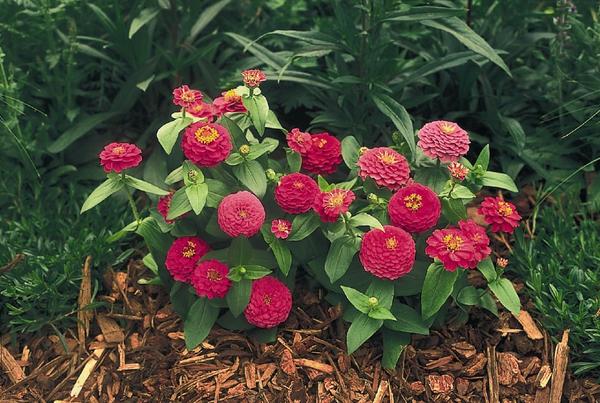

The stems grow in height a little more than half a meter. The diameter of the flowers reaches 5 cm. The plant blooms until autumn, so it will become an ornament to any flower bed. The buds of this species are distinguished by a special bright red color.
Varieties:
- Rotkophen
- Tom Tumb
Zinnia is a great plant that is suitable both for growing in a flower bed and at home. Its rich color scheme will help to fill the garden space with bright colors. A wide variety of sizes will make it possible to choose a variety for any setting. Ease of care and planting, another plus to make a flower one of the favorite for florists.
What to do if zinnia seedlings are elongated
Any seedling can stretch out, and zinnia is very prone to this, especially for the following reasons:
- Lack of light - if there is a lack of it, then the seedlings immediately begin to stretch out in search of any ray of light.
- High temperature - you should always monitor the temperature, and after the shoots begin to appear, it is worth lowering the temperature to an acceptable level.
- Too early planting - it will not bring anything good, it is highly not recommended to violate the terms for planting the plant.
What plants can zinnia be combined with
When creating a unique landscape design on your personal plot, you need to take care of the neighborhood of the majors in advance, because, despite their unpretentiousness, they do not have "friendly relations" with all flowers. The flowerbed will look harmonious, where the following plants are planted next to the zinnias:
- marigold;
- marigold;
- entrusted;
- Chinese aster.
Low-height varieties are best planted near the curb or along the edge of the flower bed. As for the tall varieties, they will become a colorful decoration for the center of the flower garden arrangement.
Zinnia seedlings picking
It has already been noted that these plants do not tolerate planting well, but there are times when you simply cannot do without it. If you initially sowed the seeds too densely, then they need to be thinned out by transplanting them into another box.
In this case, the timing of the pick is unchanged and is identical, as in other crops, in the presence of 2 or 3 grown, ideally formed leaves. The soil is allowed for use the same as for sowing, and the containers must be individual with a volume of 250 ml. Features of the pick:
- any plant needs moisture, so you first need to water the plant;
- transfer to the hole to the place of your choice;
- deepen to the cotyledonous leaves;
- sprinkle thoroughly and lightly trample the hole;
- pour with settled water.
A couple of weeks after the pick, it is necessary to comprehensively feed the seedlings with the help of mineral fertilizers.
It is possible to plant seedlings only when there will probably be no frost, otherwise the plants will not survive.
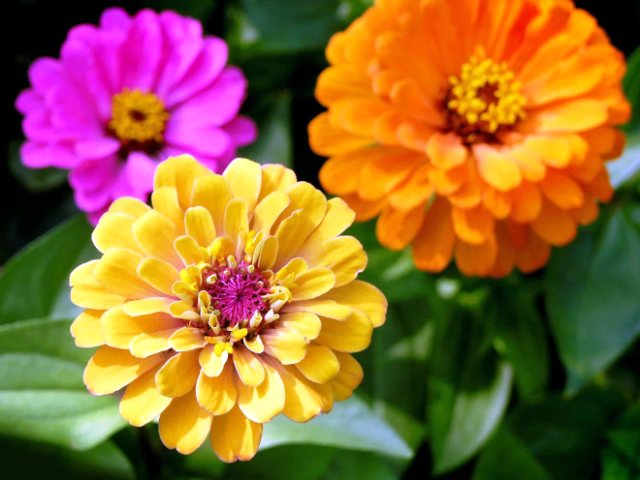

Features of watering seedlings and lighting
Zinia does not like stagnant water, she needs moderate watering, no more than 2 times a week. On cool days, it is advisable to replace watering by spraying the soil. For the prevention of root rot, a preventive treatment of the earth with a pink solution of manganese is carried out every 3 weeks. For irrigation, use settled tap water or melt water. It is collected in a watering can with a narrow tip, poured at the very root.
Any light source is suitable for illumination, it is enough to leave it on for a long time. Fluorescent or LED lamps can be placed close to the plant, they do not heat up so much. The minimum distance is 60 cm. It is advisable to increase the daylight hours to 14 hours. Then the plant will develop fully.
Procurement and storage of seeds
Major seeds can be grown on their own. After about 2 months from the time the zinnia bloomed, seeds begin to appear. They are located in the original box. In order to get high-quality ripened seeds, you must wait until they are fully ripe. When it happens, you can recognize it by the color of the box. It should turn brown. The most important thing is not to miss the moment of collection. Otherwise, the seeds will be sown on their own, and the next year, small zinnias will grow in a chaotic manner.
The seed boxes must be cut with sharp scissors. Then they need to dry well. Then carefully remove the seeds and place them in a paper bag. They are stored in a dark, dry place. With proper storage, they will not lose their germination for 3-4 years.
When harvesting seeds, it is necessary to take into account that the first flowering plants will have better seed quality than subsequent ones. Therefore, in the first inflorescences after the end of flowering, it is necessary to remove all shoots and leave the flower for the appearance of the capsule.
Transplanting zinnia to a flower bed
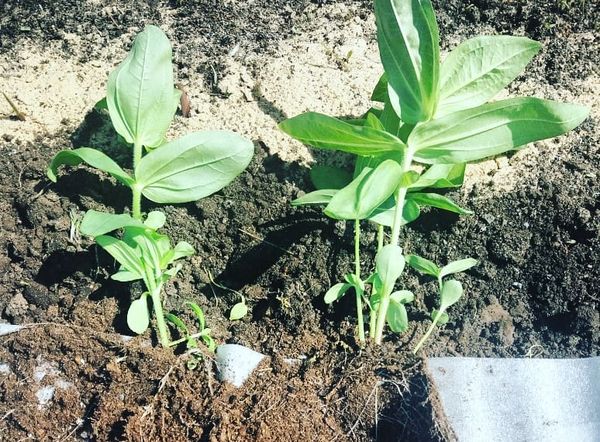

2-3 weeks before the proposed transplantation of plants into open ground, the seedlings begin to harden. The cups are taken out into the fresh air and put into the greenhouse, first for a couple of hours, then left for the whole day.
On a note. Seedlings obtained not at home, but in a greenhouse, are considered stronger and more adapted to life in the garden.
A flower bed with zinnias should be located in an open, sunny area, with loose and fertile soil. The soil suitable for plants is fertile loam or sandy loam.
Seedlings are placed at a distance of 20 cm to 50 cm, depending on the size of the adult plant. Low-growing zinnias are often placed in the foreground of mixed flower beds.
Transplanting into the ground is carried out by the transshipment method, trying not to destroy the earthen lump with roots. The work must be carried out in the evening or in cloudy weather. After planting, the flowers are watered abundantly.
Further care for zinnia is simple, it consists in watering, feeding 2-3 times over the summer and harvesting wilted inflorescences.
Pests and diseases
Zinnia is susceptible to fusarium disease, gray mold, powdery mildew. To avoid ailment, you cannot thicken the plantings and water the plants with cold water. For prevention, 2-3 times over the summer, flowers are sprayed with fungicidal preparations that kill fungal spores.
They love to feast on the delicate greens of zinnia aphids, slugs, May beetle. From aphids, plants are doused with soapy water, snails and slugs are expelled by sprinkling the soil with lime or superphosphate. With a large number of pests, spraying plants with Aktellik will help.
Growing conditions
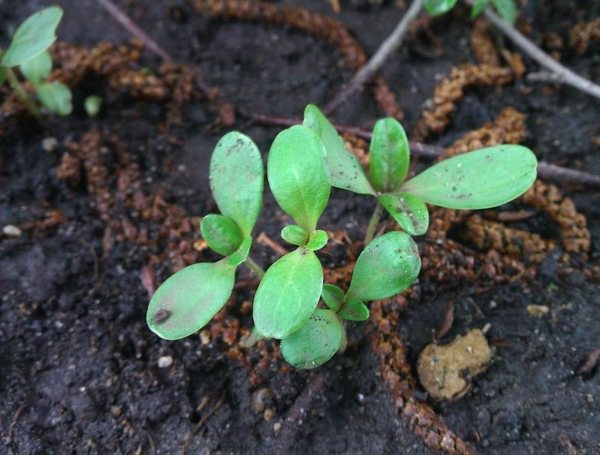

Favorable conditions - sun and warmth, windless places. The soil must be well drained - you can even sprinkle the soil on purpose. With a high groundwater table, the roots rot. Adult tall zinnias are best planted at a distance from each other, creating flower arrangements, and undersized ones along curbs, to decorate flower beds or in garden plots, as ground covers to protect against weeds.
You need to choose fertile areas with neutral acidity. Before planting seedlings or seeds, the ground is carefully dug up, no less than the depth of the shovel bayonet, removing the roots. Oxygen access is facilitated in loose soil, it is advisable to add organic matter - humus or compost. It is better to prepare a flower garden in the fall.
How do you get your seeds from flowering plants?
Before you get zinnia seeds from your flowering plants, you need to choose the specimens you like the most. This planting material retains its germination capacity for 3-4 years. It is easy to collect seeds from any varietal group. They mature even in the harsh climatic conditions of the Urals, Siberia and the Far East.
Prepare the plant for seed collection in advance. Only those buds that will ripen to collect planting material need to be left on it. All other buds should be cut before they bloom. After removing the ripe seed boll, budding will continue. On average, it takes 55 days for the seed pod to ripen from the moment the bud opens. After harvesting, the seed pods should be placed in a warm place for an additional 30 days.
Then all the capsules are opened and seeds are extracted from them. They are sorted. for landing, you should take those that have the correct triangular shape. They are located around the pod core. the rest may have insufficient germination or lose their parental decorative properties.
Remember to label the seed bags. write not only the name of the variety and color, but also the year of harvest. This will help to reject outdated planting material in a timely manner.



